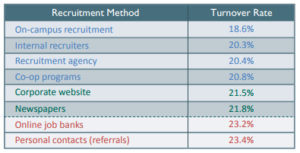Considerable time and resources are needed to recruit new employees. From candidate searches to employee onboarding, it takes a lot of effort to find qualified workers who maintain the proper cultural fit for your organization.
With so much invested in the process, employers should be looking for any way possible to maximize the retention of team members.
As data from ECO Canada’s Report on Employee Turnover shows, using the right recruitment channel can make a big difference when it comes to finding employees that express loyalty towards your organization. Although employers should use a variety of recruitment methods to access top talent, their mix of channels should all favour lower employee turnover.
On-campus recruitment has been identified as the recruitment method with the lowest turnover rate. This suggests that if employers are looking to find a good fit and keep the employee for a long time, they should be attending post-secondary job fairs and building employer branding that’s focused on post-secondary graduates.
Low-Turnover Recruitment Methods for Employers
When it comes to hiring employees, not all recruitment methods provide equal results. Data from ECO Canada’s Battling Environmental Turnover report shows a clear difference in employee turnover rates between many common recruitment methods, from co-op programs and on-campus recruitment to corporate websites and online job boards.
As a Canadian business, these figures can help you understand where to invest your recruitment resources.
Top 4 Recruitment Tips
- Get Personal: Recruitment methods with some of the best retention rates rely on members of the company establishing a personal connection with candidates. On-campus recruitment, co-op programs, and using internal recruiters can help deliver great employment experiences from day one and help new team members feel valued.
- Mix Job Boards with Other Recruitment Methods: Although job posting boards are a convenient method for employers to get in touch with qualified candidates, turnover rates for these recruits is higher than several of the alternatives. Consider incorporating other methods with higher retention rates to reduce employee turnover.
- Consider Referrals Cautiously: Personal referrals may seem like a good way to reach new prospects, it can be dangerous to accept the candidates without the thorough screening that other recruitment methods would entail. Skipping this review process could lead to a poor positional or organizational fit.
- Hire Recent Post-Secondary Graduates: New graduates are more likely to feel a sense of loyalty to your company than mature candidates who’ve held full-time permanent positions in the past. This is one of the reasons why on-campus recruitment programs and co-op placements deliver exceptional retention rates.
What Recruitment Methods Provide the Lowest Turnover?
Companies should carefully consider the recruitment methods used to find candidates. Consider ECO Canada’s data on the 12-month turnover of employees hired through various recruitment channels:

Low Turnover Recruitment Methods:
- On-Campus Recruitment (18.6%): Attending job fairs and other hiring events focused on connecting with post-secondary students.
- Internal Recruiters (20.3%): Designating employees to proactively search for and get in contact with potential candidates.
- Recruitment Agencies (20.4%): Purchasing the services of a recruitment agency to offload candidate search and reduce time commitments.
- Co-op Programs (20.8%): Hiring current post-secondary students to work for a semester with the potential of post-graduation employment.
Medium Turnover Recruitment Methods:
- Corporate Website (21.5%): Using pages hosted on a company’s website to post employer branding resources, job descriptions, and directions on how to apply.
- Newspapers (21.8%): Publishing job notices in local, regional, national, or international publications, typically as part of an ongoing recruitment campaign.
High Turnover Recruitment Methods:
- Online Job Banks (23.2%): Posting a company profile and job description online via well-known job posting sites to generate a list of potential candidates.
- Personal Contacts/Referrals (23.4%): Using the personal network of current managers and/or employees to generate a list of candidates that can be contacted and interviewed.
Government Funding Programs for Hiring Top Talent
Fortunately for businesses, there are government funding programs that can reduce the overall costs of hiring young, skilled workers. For these programs, it’s important to note that they will only fund candidates who are not currently on payroll. These incentives are meant to support the hiring of new workers; this means anybody already added to your team is ineligible for these programs.
When your company is ready to hire new employees, consider some of these top government funding options:
Hiring Post-Secondary Graduates
- Funding Amount: Up to 50% of a recent post-secondary graduate’s wages during the first 12 months of employment. Funding ranges by industry/sector but typically provides up to $14,000-$20,000 per hire.
- Project Focus: Hiring a recent (within 3 years) post-secondary graduate who’s graduated from a Canadian college or university and is currently unemployed/underemployed.
- Timeline: Some sectors/streams of funding are currently available; most receive top-ups in funding and become available by spring/summer.
- Eligibility: Manufacturers accepted.
Hiring Post-Secondary Interns
- Funding Amount: 50% of co-op’s wage up to $5,000, or 70% up to $7,000 if candidate is a woman, indigenous, has lived in Canada <5 years, has a disability, or is the first post-secondary student in their family.
- Project Focus: Hiring co-op students for a minimum 16-week period in a STEM or business-related role.
- Timeline: Currently open and accepting applications.
- Eligibility: Manufacturers accepted.
Hiring Masters Students/Grads or PhD Graduates
- Funding Amount: (Masters) $10,000 per 4-month term. Total funding/business/year is $60,000. (PhD) $35,000 per 12-month term. Total funding/business/year is $70,000.
- Project Focus: Hosting a Masters student/recent grad or PhD grad to support specific research-based or data analytic projects.
- Timeline: Currently open and accepting applications. Must submit application before offering Masters/PhD graduate a position.
- Eligibility: Manufacturers accepted.
Hiring Employees with a Disability
- Funding Amount: 50% of a new hire’s wage for 3 to 9 months to a max of $13,500.
- Project Focus: Hiring an applicant who self-identifies as having a physical or mental disability.
- Timeline: Currently open and accepting applications. Do not put the candidate on payroll before you are accepted for funding; turnaround is typically 2 weeks.
- Eligibility: Manufacturers accepted.
Use Government Funding to Recruit More Effectively
While most companies adapt recruitment strategies to fit their business model, it’s important to know that diversification is key. Leveraging multiple recruitment methods and accessing government grants are important to landing the right hire and scaling your workforce efficiently.
To learn more about hiring grants, including how to optimize the application process, please contact Mentor Works
Innovators Alliance is a peer-to-peer networking group of CEOs committed to driving business growth through innovation. Join us for an upcoming event to see what it’s all about!
Is your company innovative? Try our Innovation Assessment. It only takes 5 minutes!
Like this? You might also like:
- Cultures that Inspire!
- It’s Time to Make Diversity a Hiring Priority
- Developing a Culture of Innovation
- Top Recruitment Methods to Improve Employee Retention - July 17, 2018

